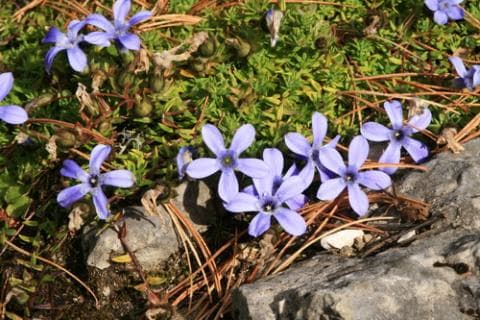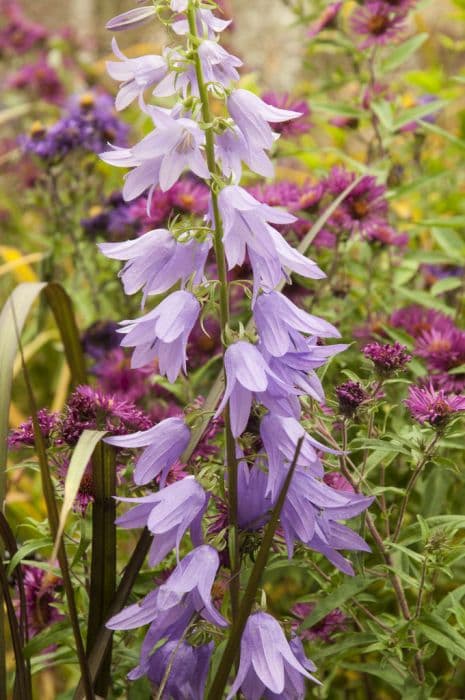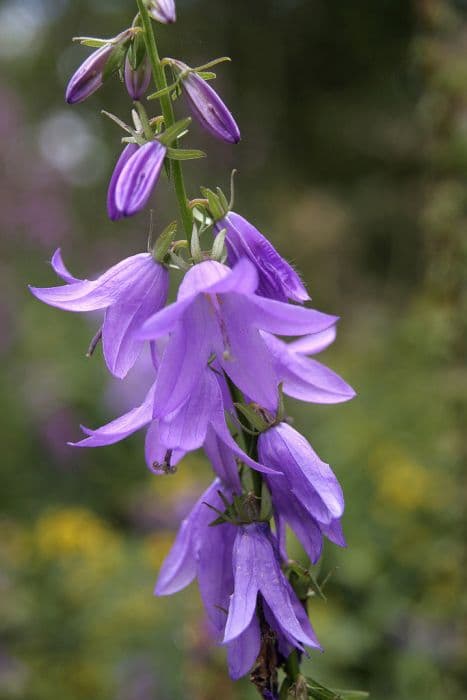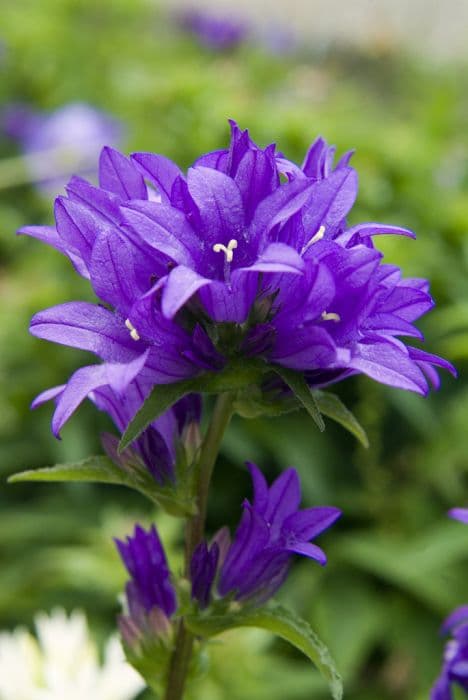Small-leafed Cyananthus Cyananthus microphyllus

ABOUT
Cyananthus microphyllus, commonly referred to as the Small-leaved Cyananthus, is a charming plant notable for its dense foliage and attractive blossoms. The leaves of this plant are small, as suggested by its name, and are typically arranged in a compact, overlapping fashion that gives the foliage a lush, textured appearance. The flowers of the Small-leaved Cyananthus are particularly striking, often a vivid blue that stands out against the greenery of the leaves. These blooms are bell-shaped, providing a cup-like structure that adds depth and interest to the plant's overall appearance. The petals may have a slightly ruffled edge, contributing to their delicate charm. Throughout the blooming period, the Small-leaved Cyananthus becomes dotted with these eye-catching flowers, which can create a carpet of blue when observed from a distance. The juxtaposition of the tiny leaves and the bold blue flowers makes this plant a favorite for adding a splash of color to garden spaces. Despite the restrictions on mentioning specific dimensions, it is important to note that the Small-leaved Cyananthus is generally considered a smaller plant, making it suitable for various garden settings where space might be limited and adding to its versatility as a planting choice. Overall, its small leaves and notably blue flowers are the defining characteristics of its appearance.
About this plant
 Names
NamesFamily
Campanulaceae
Synonyms
Small-leaf Trumpet Flower, Tiny-Leaf Cyananthus
Common names
Cyananthus lobatus var. microphyllus
 Toxicity
ToxicityTo humans
Information on Cyananthus microphyllus, commonly known as small-leaf trumpetflower, including its toxicity to humans, is limited. As of my knowledge cutoff in 2023, there are no well-documented reports of this plant being poisonous to humans. However, due to the general lack of data, it is advisable to avoid ingesting any part of the plant or using it as a herbal remedy without proper evidence of its safety. Ingesting unknown plants can lead to adverse effects, so it's important to err on the side of caution.
To pets
The toxicity of Cyananthus microphyllus, known as small-leaf trumpetflower, to pets is not well documented. As of my last update, there is insufficient information to confirm whether it is toxic to pets such as dogs and cats. However, caution should be exercised, and pets should be prevented from ingesting any part of the plant, as the impact on their health is unclear. If ingestion does occur and adverse symptoms are observed, it is important to consult a veterinarian.
 Characteristics
CharacteristicsLife cycle
Perennials
Foliage type
Deciduous
Color of leaves
Green
Flower color
Blue
Height
1 foot (0.3 meters)
Spread
1 foot (0.3 meters)
Plant type
Herb
Hardiness zones
5
Native area
Himalayas
Benefits
 General Benefits
General Benefits- Ornamental Value: Cyananthus microphyllus, also known as trailing bellflower, is often used in gardens for its attractive blue or violet bell-shaped flowers and its low trailing growth habit, ideal for rock gardens or as ground cover.
- Erosion Control: The plant can help stabilize soil in sloped areas and prevent erosion due to its mat-forming characteristic.
- Habitat Support: It can offer habitat and food for various insects, including bees and butterflies, contributing to local biodiversity.
- Low Maintenance: Trailing bellflower is considered low maintenance, requiring minimal care once established, making it a good choice for gardeners of all skill levels.
- Drought Tolerance: It is relatively drought-tolerant once established, reducing the need for frequent watering and making it suitable for xeriscaping.
 Medical Properties
Medical Properties- This plant is not used for medical purposes.
 Air-purifying Qualities
Air-purifying QualitiesThis plant is not specifically known for air purifying qualities.
 Other Uses
Other Uses- Cyananthus microphyllus, also known as Trailing Bellflower, can be used as a ground cover in rock gardens, where its low-growing habit helps to fill in gaps and add lush, green texture.
- Due to its trailing nature, Trailing Bellflower is ideal for growing over walls or in alpine trough gardens where its flowers can gracefully drape over the edges.
- The plant can be used in container gardening, as it can cascade beautifully over the sides of pots or hanging baskets, creating a waterfall-like effect.
- Trailing Bellflower may be utilized as a living mulch to preserve soil moisture and reduce weed growth around other garden plants.
- This plant is suitable for bonsai cultivation, where it can be trained and pruned to create miniature landscape scenes.
- It can be incorporated in rooftop gardens, contributing to a green cover without the need for extensive soil depth due to its shallow root system.
- The flowers of Trailing Bellflower can be used in floral arrangements for a delicate and whimsical touch due to their small size and intriguing shape.
- In photography and painting, the vibrant colors and unique form of the Trailing Bellflower can serve as an inspiring subject for nature-themed art projects.
- Trailing Bellflower can be used for educational purposes in botanic gardens and institutions to demonstrate the variety of plant life found in high-altitude flora.
- It can play a role in conservation practices, as cultivating Cyananthus microphyllus in gardens can support pollinators like bees and butterflies, contributing to the biodiversity of the area.
Interesting Facts
 Feng Shui
Feng ShuiThe plant Cyananthus microphyllus is not used in Feng Shui practice.
 Zodiac Sign Compitability
Zodiac Sign CompitabilityThe plant Cyananthus microphyllus is not used in astrology practice.
 Plant Symbolism
Plant Symbolism- Resilience: Cyananthus microphyllus, commonly known as Small-leaf blue cup, often grows in high-elevation habitats, representing the ability to thrive in challenging conditions.
- Rarity: Given its unique habitat and lesser-known status, Small-leaf blue cup symbolizes the value and beauty in rare and uncommon traits.
- Adaptability: The plant's survival in mountainous terrain signifies adaptability to changing environments and circumstances.
 Water
WaterFor the Dwarf Bluebell (Cyananthus microphyllus), regular watering is essential to keep the soil evenly moist but not waterlogged. During the active growing season in spring and summer, water the plant using approximately 8-16 ounces of water once a week. Adjust watering frequency based on rainfall and temperature, reducing the amount in cooler months. It is prudent to water in the morning to allow any excess to evaporate during the day. Always check the top inch of the soil for dryness before watering to avoid overwatering.
 Light
LightDwarf Bluebell thrives in full sunlight to partial shade. The ideal spot for this plant would be a location where it receives morning sunlight and is shaded during the hottest part of the day. If grown indoors, place it near a south-facing window with filtered light, or if outdoors, in an area with dappled light to protect it from intense afternoon rays.
 Temperature
TemperatureThe Dwarf Bluebell prefers temperate climates with an ideal temperature range between 50°F and 75°F. While it can tolerate short periods of colder weather, ensure that it is not exposed to temperatures below 32°F, as it may not survive hard freezes. Similarly, it should be kept away from excessively hot conditions above 80°F, which could cause stress to the plant.
 Pruning
PruningPruning Dwarf Bluebell is generally done to remove any dead or damaged growth and to maintain a compact shape. Pruning can be done after the flowering season in late summer or early fall. This encourages new growth and prepares the plant for the next blooming period. Cut back about a third of the plant to promote healthy, bushier growth.
 Cleaning
CleaningAs needed
 Soil
SoilFor the best growth of Cyananthus microphyllus, commonly known as Trailing Bellflower, use a well-draining soil mix with plenty of organic matter such as compost or peat moss to encourage good drainage. The soil pH should range between 5.5 and 7.0 to ensure the plant can absorb nutrients effectively.
 Repotting
RepottingTrailing Bellflower should be repotted every two to three years to prevent root-bound conditions and maintain soil fertility. It's best to repot in the spring as the plant enters a period of active growth.
 Humidity & Misting
Humidity & MistingTrailing Bellflower thrives best in moderate humidity levels. It prefers conditions that mimic its natural alpine habitat—avoid overly dry environments and provide some humidity without making the air too damp.
 Suitable locations
Suitable locationsIndoor
Place Trailing Bellflower in bright, indirect light and keep soil moist.
Outdoor
Plant in partial shade and shelter from strong winds.
Hardiness zone
5-9 USDA
 Life cycle
Life cycleCyananthus microphyllus, commonly known as Small-Leaf Trumpet-Flower, begins its life cycle with seed germination, typically occurring in a moist substrate in spring with cold stratification improving germination rates. Following germination, seedlings establish themselves, developing a root system and small leaves, and over a few seasons, the plant grows into a small mat-forming perennial. It then enters a vegetative state where it continues to grow foliage and roots. As it matures, it produces distinctive small, blue or violet trumpet-shaped flowers, generally in the summer months, attracting pollinators such as bees and butterflies. After pollination, flowers develop into capsules containing seeds that are eventually dispersed by wind or gravity. The plant may enter a period of dormancy during winter, especially in colder climates, to survive until the next growing season.
 Propogation
PropogationPropogation time
Spring to Summer
The most popular method for propagating Cyananthus microphyllus, commonly known as Small-leaved Trumpet Flower, is through seed sowing. Seeds should ideally be sown as soon as they are ripe in cold frames or pots placed in a protected outdoor location. To ensure good contact with the soil, the seeds must be lightly covered with a fine layer of soil, no more than 1/8 inch (about 3 mm) thick. It is important to maintain a consistent level of moisture without overwatering, which can cause the seeds to rot. Germination can be irregular, so patience is necessary. Once the seedlings are large enough to handle and have developed a set of true leaves, they can be transplanted into their own pots or directly into the garden if the outdoor temperatures are suitable.









